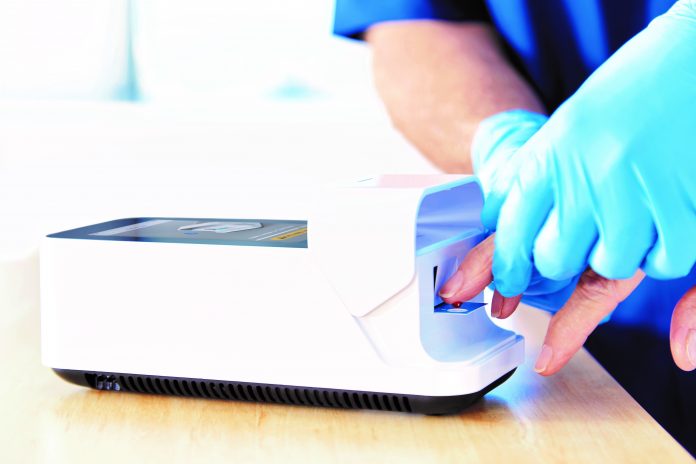
“Supporting more widespread use of rapid diagnostic technology should be a central aim of efforts to tackle the next hidden pandemic” according to LumiraDx and the British In Vitro Diagnostics Association.
Despite the availability of the C-Reactive Protein (CRP) rapid diagnostic test, which can determine whether a patient is likely to have a bacterial infection, most antibiotics are prescribed in primary care without a determination of whether the patient has a bacterial infection that can be treated by antibiotics, according to the Testing Times report released today.
Point of care CRP testing reduces antibiotic prescribing by 22-36% for respiratory tract infections (RTI),1 and 22% for COPD.2 It is one of the most effective tools there is against the leading cause of antimicrobial resistance: unnecessary antibiotic prescribing in primary care.
Doris-Ann Williams, CEO of the British In Vitro Diagnostic Association said: “As we move forward from the pressures and challenges placed on the NHS by COVID-19, it’s critical that the UK government is looking to the future and the impending crisis of antimicrobial resistance (AMR). Rapid diagnostics have a key role to play in community and primary care settings to lower unnecessary antibiotic prescribing, particularly in respiratory tract infections, and protect the healthcare system in the decades to come.”
The Government’s Five-Year Action Plan on Antimicrobial Resistance: 2019-2024, concluded that the UK does not make the best use of available diagnostic technology.3 The British In Vitro Diagnostics Association and LumiraDx are calling on the NHS, Department of Health and Social Care and NICE to unlock the potential of point of care CRP testing to prevent antimicrobial resistance.
Released today by LumiraDx in partnership with the British In Vitro Diagnostics Association, Testing Times outlines the role of rapid diagnostics in tackling AMR. It identifies barriers to their uptake in primary and community care.
Key recommendations for diagnostic testing:
- NICE should revise its assessment of diagnostic tests to include robust economic modelling of the impact of AMR to determine the cost-effectiveness of using rapid diagnostics.
- New Integrated Care Systems should leverage economies of scale and must be provided with appropriate funding arrangements and incentives to utilise rapid diagnostics in primary and community care.
- The Department of Health and Social Care and NHS England should consider reducing NHS pressures by providing rapid diagnostics in new respiratory assessment hubs.
To inform the report, healthcare professionals, academics and Government advisors on AMR shared their insights into policy and frontline challenges in a series of interviews led by Professor Jonathan Cooke, visiting Professor at the NIHR London In Vitro Diagnostics Co-operative, Department of Surgery and Cancer, Faculty of Medicine at Imperial College London and Honorary Professor in the Faculty of Biology, Medicine and Health, University of Manchester.
According to Professor Cooke, “the threat of AMR requires urgent attention and action on the part of the UK government. We’ve heard from experts and stakeholders across the board that challenges and barriers remain when looking to implement rapid point of care testing.”
Globally, it is estimated that there are at least 700,000 deaths per year as a result of antimicrobial resistant infection and this is expected to rise to ten million deaths by 2050 if action is not taken.4
About LumiraDx
LumiraDx’s diagnostic platform accurately measures CRP within four minutes of a fingerpick so that an informed decision can be made about antibiotic prescribing in the space of the first appointment.
LumiraDx is a next-generation point-of-care diagnostics company that is transforming community-based healthcare. The company’s portable and lab comparable point of care diagnostic platform supports a broad menu of tests, with 30 either on the market or in development, covering infectious diseases, cardiovascular diseases, diabetes, and coagulation disorders. Further information on LumiraDx is available at www.lumiradx.com
References
- Cooke J, Llor C, Hopstaken R, Dryden M, Butler C. Respiratory tract infections (RTIs) in primary care: narrative review of C reactive protein (CRP) point-of-care testing (POCT) and antibacterial use in patients who present with symptoms of RTI. BMJ Open Respir Res. 2020;7(1):e000624. doi:10.1136/bmjresp-2020-000624
- Butler CC, Gillespie D, White P, et al. C-Reactive Protein Testing to Guide Antibiotic Prescribing for COPD Exacerbations. N Engl J Med. 2019;381(2):111-120. doi:10.1056/NEJMoa1803185
- Department of Health and Social Care. UK 5-year action plan for antimicrobial resistance 2019-2024. January 2019. Available: https://www.gov.uk/government/publications/uk-5-year-action-plan-for-antimicrobial-resistance-2019-to-2024
- The Review on Antimicrobial Resistance. Tackling Drug-Resistant Infections Globally: Final Report and Recommendations. May 2016. Available: https://amr-review.org


















